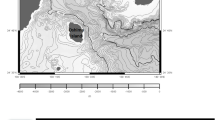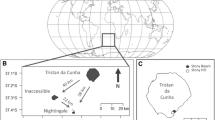Abstract
Behavioural plasticity of top marine predators to adapt to seasonal changes in the behaviour of their prey is little understood. Here, we used data from 16 multi-sensor archival tags attached to killer whales in 2005, 2006 and 2009 to evaluate whether and how their feeding behaviour varied according to seasonal life-stages (overwintering, feeding and spawning) of their herring prey. Feeding periods with tail slaps were consistently characterized by non-directional movement with the production of calls and echolocation clicks, but angular deviation in heading during feeding periods was lower during overwintering than spawning prey life-stages. Tail slaps were produced more often at depths >10 m in the feeding and spawning prey life-stages, while during overwintering, they often occurred at <10 m depth, indicating the depth of feeding changed with predicted positions of prey in the water column. Echolocation clicks were produced less often during feeding upon overwintering herring, suggesting that visual cues may be used more in winter during daytime due to better underwater visibility. Thus, while maintaining an encircling strategy to exploit the year-round anti-predator schooling behaviour of their herring prey, observed variations in details of killer whale feeding behaviour across prey life-stages are likely driven by the size and depth of herring schools, and the cost-benefit balance of bringing herring schools to the surface in different environmental contexts. However, observed variations do not appear strong enough to indicate reciprocal phenotypic plasticity by the herring prey which seem to rely primarily upon general anti-predator strategies.





Similar content being viewed by others
References
Agrawal AA (2001) Phenotypic plasticity in the interactions and evolution of species. Science 294:321–326
Axelsen BE, Nøttestad L, Fernö A, Johannessen A, Misund OA (2000) ‘Await’ in the pelagic: dynamic trade-off between reproduction and survival within a herring school splitting vertically during spawning. Mar Ecol Prog Ser 205:259–269
Baird RW, Dill LM (1996) Ecological and social determinants of group size in transient killer whales. Behav Ecol 7:408–416
Baird RW, Hanson MB, Dill LM (2005) Factors influencing the diving behaviour of fish-eating killer whales: sex differences and diel and interannual variation in diving rates. Can J Zool 83:257–267
Beck S, Kuningas S, Esteban R, Foote AD (2011) The influence of ecology on sociality in the killer whale (Orcinus orca). Behav Ecol 23:246–253
Bel’kovich VM, Ivanova EE, Yefremenkova OV, Kozarovitsky LB, Kharitonov SB (1991) Searching and hunting behavior in the bottlenose dolphin (Tursiops truncatus) in the Black Sea. In: Pryor K, Norris K (eds) Dolphin societies: discoveries and puzzles. University of California Press, Berkeley, pp 38–67
Cosolo M, Ferrero EA, Sponza S (2010) Prey ecology and behaviour affect foraging strategies in the Great Cormorant. Mar Biol 157:2533–2544
de Groot SJ (1980) The consequences of marine gravel extraction on the spawning of herring, Clupea harengus Linné. J Fish Biol 16:605–611
Domenici P, Batty RS, Similä T, Ogam E (2000) Killer whales (Orcinus orca) feeding on schooling herring (Clupea harengus) using underwater tail-slaps: kinematic analyses of field observation. J Exp Biol 203:283–294
Enger PS (1967) Hearing in herring. Comp Biochem Physiol 22:527–538
Foote AD, Newton J, Piertney SB, Willerslev E, Gilbert MTP (2009) Ecological, morphological and genetic divergence of sympatric North Atlantic killer whale populations. Mol Ecol 18:5207–5217
Foster EA, Franks DW, Morrell LJ, Balcomb KC, Parsons KM, van Ginneken A, Croft DP (2012) Social network correlates of food availability in an endangered population of killer whales, Orcinus orca. Anim Behav 83:731–736
Friedlaender AS, Hazen EL, Nowacek DP, Halpin PN, Ware C, Weinrich MT, Hurst T, Wiley D (2009) Diel changes in humpback whale Megaptera novaeangliae feeding behavior in response to sand lance Ammidytes spp. behavior and distribution. Mar Ecol Prog Ser 395:91–100
Friedlaender AS, Tyson RB, Stimpert AK, Read AJ, Nowacek DP (2013) Extreme diel variation in the feeding behavior of humpback whales along the western Antarctic Peninsula during autumn. Mar Ecol Prog Ser 494:282–289
Guinet C (1991) Intentional stranding apprenticeship and social play in killer whales (Orcinus orca). Can J Zool 69:2712–2716
Hoelzel AR (1991) Killer whale predation on marine mammals at Punta Norte, Argentina; food sharing, provisioning, and foraging strategy. Behav Ecol Sociobiol 29:197–204
Højsgaard S, Halekoh U, Yan J (2006) The R package geepack for generalized estimating equations. J Stat Softw 15:1–11
Holst JC, Røttingen I, Melle W (2004) The herring. In: Skjoldal HR (ed) The Norwegian sea ecosystem. Tapir Academic Press, Trondheim, pp 203–226
Jakobsson J, Stefánsson G (1999) Management of summer-spawning herring off Iceland. ICES J Mar Sci 56:827–833
Johnson MP, Tyack PL (2003) A digital acoustic recording tag for measuring the response of wild marine mammals to sound. IEEE J Ocean Eng 28:3–12
Kvadsheim PH, Lam FPA, Miller PJO, Alves AC, Antunes R, Bocconcelli A, van Ijsselmuide S, Kleivane L, Olivierse M, Visser F (2009) Cetaceans and naval sonar—the 3S-2009 cruise report (FFI-rapport 2009/01140 ed.). Forsvarets Forskningsintitutt, Kjeller
Lima SL (2002) Putting predators back into behavioural predator–prey interactions. Trends Ecol Evol 17:70–75
Lopez JC, Lopez D (1985) Killer whales (Orcinus orca) of Patagonia, and their behavior of intentional stranding while hunting nearshore. J Mamm 66:181–183
Mann DA, Popper AN, Wilson B (2005) Pacific herring hearing does not include ultrasound. Biol Lett 1:158–161
Miller PJO (2002) Mixed-directionality of killer whale stereotyped calls: a direction of movement cue? Behav Ecol Sociobiol 52:262–270
Miller PJO, Johnson MP, Tyack PL, Terray EA (2004) Swimming gaits, passive drag and buoyancy of diving sperm whales Physeter macrocephalus. J Exp Biol 207:1953–1967
Miller PJO, Shapiro AD, Deecke VB (2010) The diving behaviour of mammal-eating killer whales (Orcinus orca): variations with ecological not physiological factors. Can J Zool 88:1103–1112
Miller PJO, Antunes R, Alves AC, Wensveen P, Kvadsheim P, Kleivane L, Nordlund N, Lam FP, van IJsselmuide S, Visser F, Tyack P (2011) The 3S experiments: studying the behavioural effects of naval sonar on killer whales (Orcinus orca), sperm whales (Physeter macrocephalus), and long-finned pilot whales (Globicephala melas) in Norwegian waters. Scottish Oceans Inst. Tech. Rept., SOI-2011-001
Morin PA, Archer FI, Foote AD, Vilstrup J, Allen EE, Wade P, Durban J, Parsons K, Pitman R, Li L, Bouffard P, Nielsen SCA, Rasmussen M, Willerslev E, Gilbert MTP, Harkins T (2010) Complete mitochondrial genome phylogeographic analysis of killer whales (Orcinus orca) indicates multiple species. Genome Res 20:908–916
Norris K, Dohl TP (1980) The structure and functions of cetacean schools. In: Herman LM (ed) Cetacean behavior: mechanisms and functions. Wiley, New York, pp 211–261
Nøttestad L, Axelsen BE (1999) Herring schooling manoeuvres in response to killer whale attacks. Can J Zool 77:1540–1546
Nøttestad L, Similä T (2001) Killer whales attacking schooling fish: why force herring from deep water to the surface? Mar Mamm Sci 17:343–352
Nøttestad L, Aksland M, Beltestad A, Fernö A, Johannessen A, Misund OA (1996) Schooling dynamics of Norwegian spring spawning herring (Clupea harengus) in a coastal spawning area. Sarsia 80:277–284
Nøttestad L, Fernö A, Axelsen B (2002) Digging in the deep: killer whales’ advanced hunting tactic. Polar Biol 25:939–941
Nøttestad L, Fernö A, Misund OA, Vabø R (2004) Understanding herring behaviour: linking individual decisions, school patterns and population distribution. In: Skjoldal HR (ed) The Norwegian sea ecosystem. Tapir Academic Press, Trondheim, pp 227–262
Óskarsson GJ, Gudmundsdottir A, Sigurdsson T (2008) Variation in spatial distribution and migration of Icelandic summer-spawning herring. ICES J Mar Sci 66:1762–1767
R Development Core Team (2011) R: A language and environment for statistical computing. R Foundation for Statistical Computing, Vienna, Austria
Roupert-Coudert Y, Kato A, Bost C-A, Rodary D, Sato K, Le Maho Y, Naito Y (2002) Do Adélie penguins modify their foraging behaviour in pursuit of different prey? Mar Biol 140:647–652
Samarra FIP, Deecke VB, Vinding K, Rasmussen MH, Swift RJ, Miller PJO (2010) Killer whales (Orcinus orca) produce ultrasonic whistles. J Acoust Soc Am 128:EL205–EL210
Schorr JL, Baird RW, Foster JJ, Hanson MB (2001) Diving behaviour of fish-eating killer whales off southern Iceland. In: Proceedings of the 14th biennial conference on the biology of marine mammals, 28 November–3 December, Vancouver
Shapiro AD (2008) Orchestration: The movement and vocal behavior of free-ranging Norwegian killer whales (Orcinus orca). Dissertation, Massachusetts Institute of Technology and Woods Hole Oceanographic Institution
Sigurjónsson J, Lyrholm T, Leatherwood S, Jónsson E, Víkingsson G (1988) Photoidentification of killer whales, Orcinus orca, off Iceland, 1981 through 1986. Rit Fisk 11:99–114
Similä T (1997) Sonar observations of killer whales (Orcinus orca) feeding on herring schools. Aquat Mamm 23:119–126
Similä T, Ugarte F (1993) Surface and underwater observations of cooperatively feeding killer whales in northern Norway. Can J Zool 71:1494–1499
Simon M, Wahlberg M, Ugarte F, Miller LA (2005) Acoustic characteristics of underwater tail slaps used by Norwegian and Icelandic killer whales (Orcinus orca) to debilitate herring (Clupea harengus). J Exp Biol 208:2459–2466
Simon M, Ugarte F, Wahlberg M, Miller L (2006) Icelandic killer whales Orcinus orca use a pulsed call suitable for manipulating the schooling behaviour of herring Clupea harengus. Bioacoustics 16:57–74
Simon M, McGregor PK, Ugarte F (2007) The relationship between the acoustic behaviour and surface activity of killer whales (Orcinus orca) that feed on herring (Clupea harengus). Acta Ethol 10:47–53
Skaret G, Nøttestad L, Fernö A, Johannessen A, Axelsen BE (2003) Spawning of herring: day or night, today or tomorrow? Aquat Liv Res 16:299–306
Stenersen J, Similä T (2004) Norwegian killer whales. Tringa forlag. Henningsvær, Norway
Visser I, Smith TG, Bullock ID, Green GD, Carlsson OGL, Imberti S (2008) Antarctic peninsula killer whales (Orcinus orca) hunt seals and a penguin on floating ice. Mar Mamm Sci 24:225–234
Whitman DW, Agrawal AA (2009) What is phenotypic plasticity and why is it important? In: Whitman DW, Ananthakrishnan TN (eds) Phenotypic plasticity of insects. Science Publishers, Enfield, pp 1–63
Würsig B, Würsig M (1980) Behavior and ecology of the dusky dolphin, Lagenorhynchus obscurus, in the South Atlantic. Fish Bull 77:871–890
Zar JH (1984) Biostatistical analysis, 2nd edn. Prentice-Hall, New Jersey
Acknowledgments
We would like to thank all the people who participated in the various field seasons in Norway and Iceland for their help and efforts in collecting the data presented here. All data were collected as part of the 3S collaborative research program, and 2005 data were collected in collaboration with A. D. Shapiro. F. Plard and A. Podt helped with analysis of the Norway 2005 and 2009 acoustic data, respectively. Logistical support in Iceland was provided by Viking Tours and the Vestmannaeyjar Research Centre, particularly P. Jónsson. We would like to thank the Woods Hole Oceanographic Institute, particularly A. Bocconcelli, M.P. Johnson and P.L. Tyack for support with tagging and P. Wensveen for useful comments on the manuscript. Animal experiments were carried out under permits issued by the Norwegian Animal Research Authority (Permit No. 2004/20607 and S-2007/61201), in compliance with ethical use of animals in experimentation. Approval for field research in Iceland was granted by the Ministry of Fisheries. Ethics approval was granted by the Animal Welfare Ethics Committee reference PCD 60/2609 of the University of St. Andrews. This work was supported by a studentship from Fundação para a Ciência e a Tecnologia (grant number SFRH/BD/30303/2006 to F.I.P.S.), a Russell Trust Award of the University of St Andrews and the Office of Naval Research. This manuscript was greatly improved by helpful comments from two anonymous reviewers.
Author information
Authors and Affiliations
Corresponding author
Additional information
Communicated by G. Pierce.
Electronic supplementary material
Below is the link to the electronic supplementary material.
227_2015_2626_MOESM1_ESM.mp3
Supplementary material 1: Acoustic recording of a killer whale tail slap when feeding upon herring in its feeding life-stage, as illustrated in Figure 5 (MP3 78 kb)
227_2015_2626_MOESM2_ESM.mp3
Supplementary material 2: Acoustic recording of a killer whale tail slap when feeding upon herring in its overwintering life-stage, as illustrated in Figure 5 (MP3 78 kb)
227_2015_2626_MOESM3_ESM.mp3
Supplementary material 3: Acoustic recording of a killer whale tail slap when feeding upon herring in its spawning life-stage, as illustrated in Figure 5 (MP3 78 kb)
Rights and permissions
About this article
Cite this article
Samarra, F.I.P., Miller, P.J.O. Prey-induced behavioural plasticity of herring-eating killer whales. Mar Biol 162, 809–821 (2015). https://doi.org/10.1007/s00227-015-2626-8
Received:
Accepted:
Published:
Issue Date:
DOI: https://doi.org/10.1007/s00227-015-2626-8




